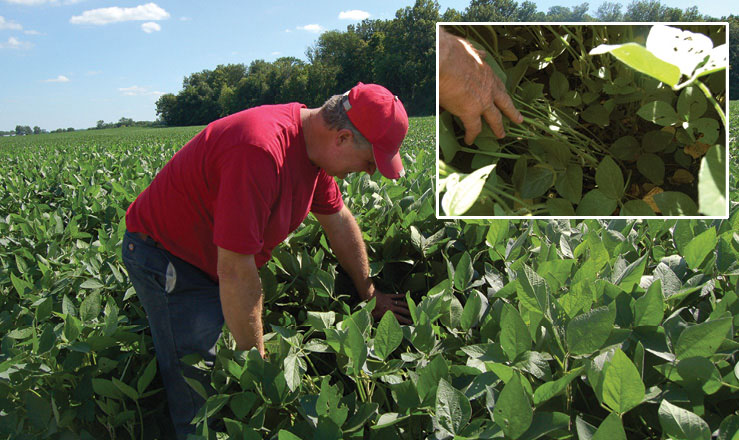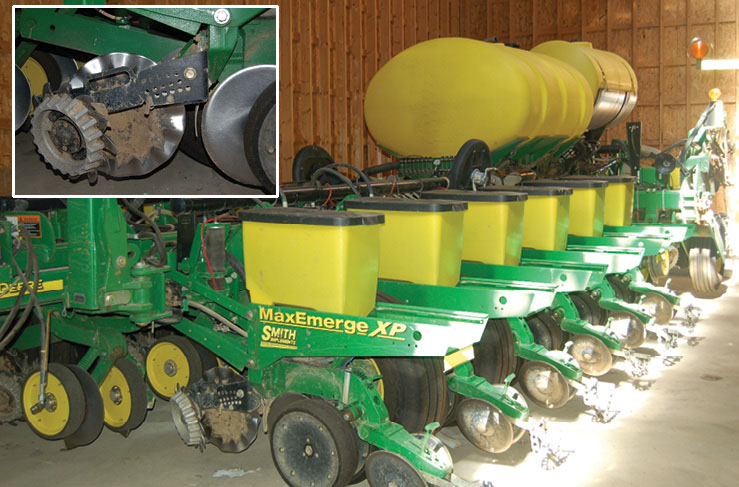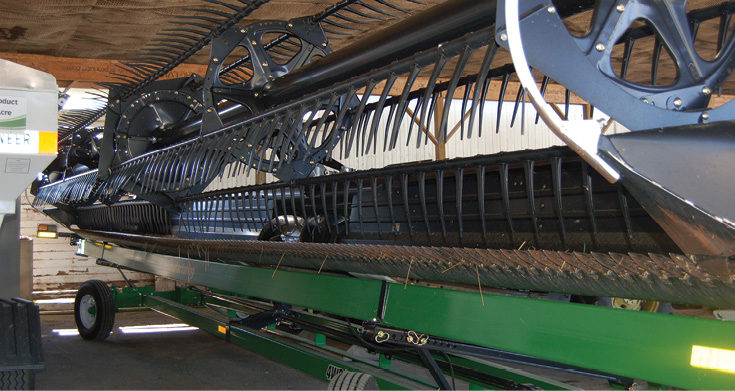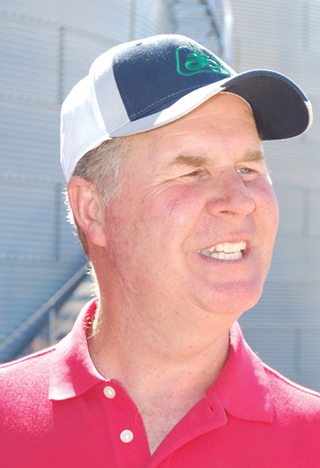Check The Specs...
NAME: Keith Kemp
LOCATION: West Manchester, Ohio
YEARS NO-TILLING: 30
ACRES: 1,700
CROPS: Corn, soybeans and winter wheat
No-Till fascinates me. It appeals to the part of my personality that likes a challenge.
I got my first taste of no-till more than 30 years ago. I went to some meetings on ridge-till, and the benefits of earthworms and soil life, and I just got excited.
I loved the idea of managing our soils as a living thing. They’re not just dirt, like so many people think. Those farmers just go through the motions. I like to dig in and see how our soil life is doing, and manage with that in mind.
I started small with no-till, dedicating just 100 acres to experimenting with it. I had concerns about how to manage the residue, and if I could even raise no-tilled corn.
I just kept playing with it and researching, and then row cleaners came out. We put those on the planter and went 100% no-till almost immediately. Now I’m not sure how farmers are able to farm profitably without no-tilling.
Handling Residue
We definitely had our challenges early on. Before adding row cleaners, we struggled with residue and all the issues that went with it: cold soils, wet soils, hairpinning, disease and insects. Once we got row cleaners, a lot of those problems went away.
Our Yetter row cleaners clear a 6-inch path to plant into. They help warm the soil up and get us in the field faster in the spring. Before row cleaners we had problems with insects like cutworms. It was amazing how much row cleaners helped with that.
Once we were all in with no-till, we just kept working at pushing our yields and our soil resources. One thing I track closely is soil organic matter. It’s what dictates our water-holding capacity and availability of soil fertility.
One of the reasons I raise corn-on-corn on 20% of my acres is because it leaves a lot of residue for my soil microbes and contributes to soil organic matter.
When I first started no-tilling, soil organic-matter levels ranged from 2.3% to 2.9%, which isn’t too bad. In the early years of no-till, my soil organic matter would increase 0.1% every 3 years or so.
Now that our no-till system is more mature, we’ve seen almost a 0.1% increase in just 1 year. Our soil organic-matter levels are 3.1% to 3.9% now. That pays off because my soils retain more water — that comes in handy when we have dry years.
While residue plays a positive role in my operation, I still look for new ways to make it work for me instead of against me.
Corn-on-corn practices leave us with a lot of residue to deal with, and corn stover usually sticks around for at least 2 years. My goal is for it to be incorporated back into the soil by my soil microbes and earthworms in just 1 year.
Earlier this year I purchased and installed a Yetter Stalk Devastator, a roller that is mounted underneath the combine header. It smashes the stalks down and breaks them up without chopping them.
I don’t want my corn residue chopped, because it forms a mat of residue that blankets the soil and makes warming and drying of the soil difficult in the spring.
By smashing the stalks into the ground and breaking them up, I’m hoping to provide more entry points for microorganisms to get at the stalks and break them down faster.
Soybean Strategies

Everyone talks about corn, but we like to push our no-till soybean yields, too. In our onfarm test plots, we’re shooting for 100-bushel soybeans and we’ve achieved 82 bushels so far.
We take strategies that work in those plots and apply them to our production acres on a larger scale. About two-thirds of our acres are planted to corn, and 40 acres to winter wheat double-cropped with soybeans, and the rest to soybeans.
We call soybeans our cover crop, and there’s definite value there. With soybeans selling in the $12 to $15 range, our double-crop wheat and soybean acres have been our top-grossing crop.
Prior to planting soybeans, we variable-rate apply a combination of potash and pellet lime according to prescriptions created by data from grid sampling and yield maps.
We’ve really seen an advantage with the pellet lime. The soybean plant seems to utilize it to help fix more nitrogen, and it helps the herbicides work better. I’ve seen a 2- to 4-bushel increase in soybean yields. Soybeans really use the potash, too. A soybean plant uses 1.4 pounds of potassium per bushel produced. If we want to raise 100-bushel soybeans, we need to make sure there are 140 pounds of potash available to that plant. It’s necessary for us to reach top yields.
I still drill my soybeans in 7-inch rows using a John Deere 1560 no-till drill. Yields are better for us with the narrow drilled rows than the split rows.
Because soybean planting doesn’t always occur in the best conditions, I’ve equipped my drill with spider-type closing wheels. If conditions are a little wet, those wheels can close the seed trench without creating a lot of compaction. It gives us a little more flexibility and is more forgiving.
Our soybean populations are a little high by most standards. We plant around 180,000 seeds per acre. It’s more standard to plant 120,000 to 140,000 per acre, but I see it as cheap insurance.
The goal is to harvest 150,000 to 160,000 plants per acre, so by planting a little high I can lose a few plants to residue, insects and disease and still hit my mark. Those that go with lower populations like to count on the soybeans branching out and producing more, but we’ve found that we get our highest soybean yields with the higher populations.
Our in-season management includes diligent scouting for pests and fungal diseases. If we need to spray, we will. We also like to give our soybeans a little kick with a foliar feeding. A 5-13-8 plus zinc, copper, boron and manganese micronutrient blend and a little nitrogen is mixed with our last glyphosate application of the season and is applied when the soybeans are about 6 inches tall. It seems to give the soybeans a little boost and offset any stress caused by the glyphosate application.
Our corn-heavy rotation seems to work in our favor when it comes to soybean yields, too. We get our best stand of soybeans when they’re planted after 2 years of corn. It seems to do a good job of breaking up the disease and pest cycle, and we see a 3- to 6-bushel yield advantage.
Precision Push
Like everyone else, we’re pushing hard on our farm to get to 300-bushel corn. We’ve managed to hit 289 bushels in our test plots, so we’re very, very close.
A lot of people believe that to hit those high yields you have to really push fertility, but I don’t think that’s the case. For me, it’s about accuracy and dealing with insect and disease issues in a timely fashion.
Accuracy is a front we’ve made significant progress on in the last 5 years. Our big steps forward started with installing a Precision Planting 20/20 AirForce system that automatically measures and adjusts down pressure on our John Deere 1770NT planter, so our seeds are planted at a correct and consistent depth.
When necessary, more pressure is applied, and when that’s not needed, pressure is backed off so we don’t pack the soil in the seed trench. It does a great job of accurate placement and gets us closer to the picket fence stand.
Initially I just had the 20/20 SeedSense and was getting about 90% to 92% perfect stands. With the addition of the AirForce system I was able to push precision to 98%.
The higher our populations get with the newer hybrids, the more important it is to get excellent singulation and the perfect stand. We’re currently planting at about 35,800 plants per acre.
If you have a skip, you’re losing yield because there’s nothing there. A double results in smaller ears and, of course, smaller yields. We have to get everything perfect to hit those high corn yields.
Auto-steer has been our latest and greatest precision purchase. It was first installed on our new combine, and in 2012 we installed it on every other piece of equipment we own. The savings we achieve by not overlapping atrociously expensive seed and other inputs have us on track to pay off the systems in just 2 years.
We had GPS guidance in the past, but auto-steer just takes it to the next level as it saves on driver fatigue and driver error. It’s especially useful when planting our corn-on-corn acres because we can find the old row and plant exactly 6 inches off to the side of it.
Consistently hitting that 6-inch offset mark is critical because staying off the old row means our expensive seed isn’t planted in the root ball of last year’s crop. Planting into a root ball usually means poor seed-to-soil contact and poor germination.
Now that we’re not just eyeballing it to stay off the row we’re getting a lot better germination and emergence.
Corn-On-Corn Challenges

Corn-on-corn acres are plenty challenging in a conventional system, and take even more attention in no-till.
That said, I’ve been pretty successful in raising no-till corn-on-corn. I pick a hybrid with good disease resistance and manage it to succeed.
Seed is planted with an in-furrow pop-up formula of 6-23-6 with zinc, boron, copper and manganese, and a little fertilizer.
As soon as the plant sprouts, the root picks up a little fertilizer, giving it the boost to grow out to the 10-34-0 fertilizer and 28% nitrogen we also place in 2-by-2-inch bands with the planter.
Pop-up fertilizer and the liquid fertilizer together have given us anywhere from a 6- to 10-bushel advantage. I’m also sure to give my second-year corn 30 extra units of nitrogen because it’s not getting the extra little nitrogen boost that it would if it followed soybeans.
I’m fairly particular, if not a little old school, with my planter setup.
My floating row cleaners, with depth-gauge wheels, clear a 6-inch path for me to plant into. I also run a wavy no-till coulter. If the soil is really dry, I like that coulter there to cut the slot and take the pressure off of my openers.
I prefer cast-iron closing wheels to the new spiked tooth wheels because they have a sharper edge to press down the soil. I’m also a real believer in drag chains to pull sod clumps back over the trench and cover them up when conditions are a little wet.
Once the seed’s in the ground, it’s about managing the disease and insect pressures. There are a lot of fungi and bacteria living in the no-till residue. That can result in grey leaf spot, Goss’s wilt, rusts and other disease problems popping up. All of our corn-on-corn acres get a fungicide and insecticide application at tassel to offset the higher risk.
In my personal push to exceed the 300-bushel mark, I don’t believe that dumping a bunch of fertilizer on is the key. Fertilizer management really hasn’t changed much over the years, and I feel I get just as good of an advantage from having a healthy, functioning soil.
For me, the next yield advantages will come from better management of insects and diseases. Better products and more timely treatments will get us there. It just doesn’t seem practical to apply 500 pounds of nitrogen.
Air Capacity
Tile is an extremely valuable no-till tool for our farm. It’s the first thing we install when we get a new farm, and we’ve even re-tiled our acres that had old tile. We believe that tile opens up our soils and allows them to breathe.
Our soils are a mixture of black loam and clay. They can be a little harder to dry out. On wet years, tile works with no-till to move water through the soil profile and gets us in the field faster.
The classic no-till line is that you have to wait 2 to 3 days after the neighbors are in the field before you can plant. But with tile, I can start planting 2 to 3 days before the neighbors.
Tile performs in dry years, too. There’s more air in the soil that helps microbial and earthworm activity. The soil microbial activity builds soil structure, and earthworms can burrow all the way down to the tile. My corn roots follow those burrows and expand through more of the soil profile.
In wet or dry conditions, that larger root system is able to pull nutrients and water from more cubic inches of soil.









Post a comment
Report Abusive Comment